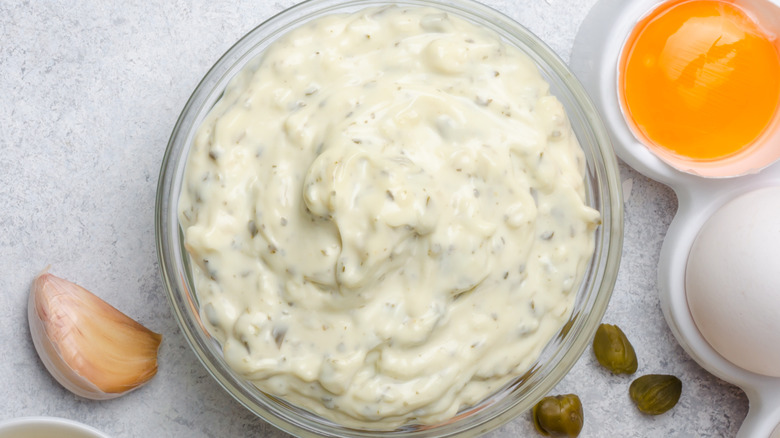Remoulade Vs. Tartar Sauce: The Key Differences And Which Is Better For Fish
Condiments are some of the most passionate "love it or leave it" flavors across the board. Ketchup or mustard on a hot dog? Ranch (thank you, Domino's) or pepper flakes for pizza? And don't even get started on the virtues or pitfalls of mayonnaise unless you're in for a good, long debate. However, there are some condiments that are perhaps lesser known (in some North American households at least), but incredibly delicious, versatile, and, in fact, easy to make at home.
In this case, the sauces at stake are tartar sauce and remoulade — two condiments that, at first, might seem very similar. They are, in fact, similar in that their base is mayonnaise but ... that's kind of where it ends. Take a look at remoulade, then at tartar sauce, and see if you would ever confuse one for the other again. Oh, the one other way they are similar is that they are both delicious and easy to make at home. Which, however, is better for fish? Read on and find out.
In corner one: Tartar sauce
Though tartar sauce likely originated in the 1800s, it's persevered as one of the world's best-beloved condiments, especially for fried fish. Traditionally, once you have the mayonnaise (or aioli) base, additions include pickles, lemon juice, capers, and fresh herbs. Dill, parsley, and tarragon are all at home with tartar sauce, which can also include other kinds of pickles besides cucumbers. For example, small pickled onions add a tangy, pleasant taste.
Tartar sauce has all of the benefits of creamy richness from its base, bright acidity from the lemon and pickles, and freshness from the herbs. It pairs well with freshly fried fish and shellfish and works in place of classic mayonnaise on a fried fish sandwich. Interestingly, if you add chopped hardboiled eggs, it transforms into sauce gribiche. So, what's the difference between tartar sauce and its creamy cousin, remoulade? In a couple of words: A lot.
In corner two: Remoulade
Though they share that same creamy base, remoulade has different additions that give it an aromatic, deeply flavored taste that's all its own. It's classically made by adding something that turns it yellow or orange, like turmeric, mustard, or even curry powder. It can also include ketchup, which offers it a sweet tang, and something fishy like chopped anchovies or Worcestershire sauce. Even if you're somebody who thinks you don't like the way anchovies taste, remoulade might change your mind. The anchovies aren't the main flavor here, but rather a deeply savory, salty note that gives the sauce incredible depth and richness.
Remoulade is incredibly popular in Cajun and Creole cuisines where it's a common addition to cocktail shrimp po'boy sandwiches. Interestingly, remoulade is used to make celeriac remoulade, using shredded celery root as its base. Its most similar common American counterpart is coleslaw. This said, it is of course also delicious with fried seafood, but with a taste all its own.
So which is best for fish? That was, of course, a trick question — because they are both fantastic with all sorts of seafood, and it's totally up to the diner if they want remoulade, tartar sauce, or even both.


